A cordless drill is of no use with a juiceless battery. Therefore, every manufacturer provides a dedicated charger for the batteries, often inside the package.
In a worst-case scenario, the battery charger can die for various reasons. This blog post will discuss how to charge a cordless drill battery or any battery without its official charger.
You can charge a battery without a charger using a car battery if both are rated at 12V. Using a variable DC voltage source is also a very reliable way to charge any rechargeable battery. You can also use a laptop charger for an 18V or 20V drill battery or AA cells attached in series or another drill battery or a balance lipo charger. You can also use a 12V solar panel to charge a battery without a charger.
The science behind charging a cordless battery is the same as charging a Li-ion battery with a charger. The science behind charging a Li-ion battery is the same as charging any rechargeable (this is important) battery.
How to charge any battery without a charger?
The basic science of charging any rechargeable battery is to provide the rated voltage of the battery at both terminals by connecting the positive terminal of the voltage source with the positive terminal of the battery you are charging and the negative terminal of the voltage source with the negative terminal of the battery you are charging.
To understand it better, check the image below. A rechargeable battery is connected with a variable voltage source byconnecting the positive terminal of the voltage source with the battery’s positive terminal and the negative terminal of the voltage source with the battery’s negative terminal.
In the first setup on the left, the voltage source is 0V, so the battery is not charging yet. However, once the voltage source is switched on to 12.0V, it’s charging. I have applied 12V because the battery we are charging is also rated at 12V.
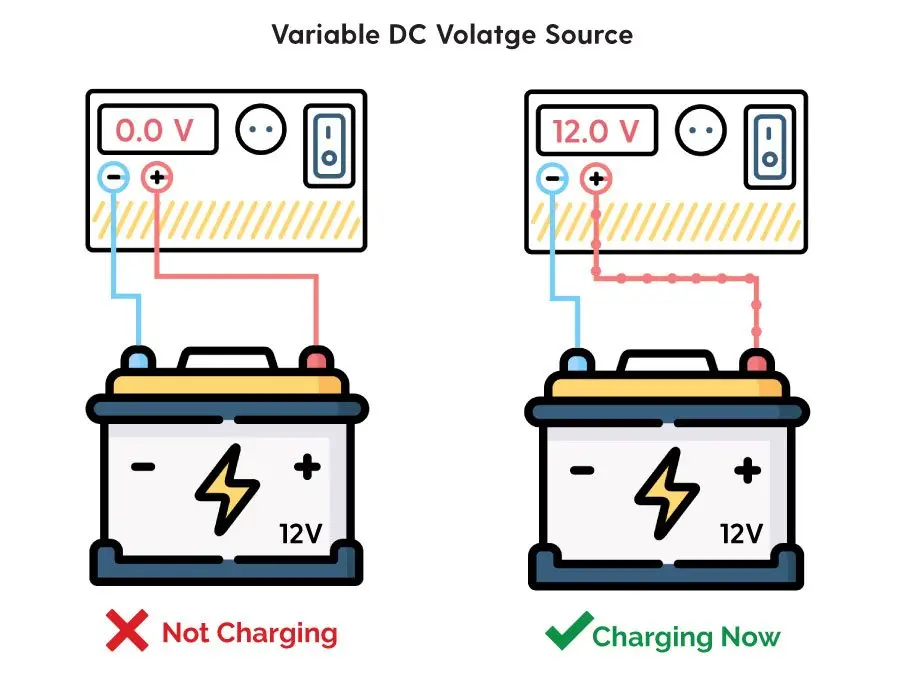
Once the voltage goes up to 12 V, it starts charging. In reality, it is not that simple. The charging starts as soon as the potential difference rises.
This means that if a 12 V battery got discharged and went down to 6V, as soon as you connect a voltage source above 6, it will start charging. The charging rate is also directly proportional to the voltage difference.
Quick Tip: Get yourself this inexpensive voltage meter by Amazon Basics to properly check your battery voltages while you charge and discharge it. (An expensive one by FLUKE for serious sh*t)
If your battery has discharged to 6V and you have connected it with a 12V voltage source, it will start to charge quickly, and as it approaches 12V, the charging speed will drop significantly.
This same technique is also used in Fast Charging. A higher voltage is applied than the rated voltage of the rechargeable battery at the beginning of the charge cycle. Then, it is carefully reduced to the battery’s rated voltage when the battery approaches full charge.
These variable voltage sources are pretty expensive, but you can get this option from Amazon at a reasonable price. This is another very cheap alternative, but the quality is not outstanding.
Caution: Fast charging needs a proper BMS (Battery Management System) to avoid any mishap or explosion. All batteries are not designed to stand fast charging as a lot of heat is produced when you fast charge a battery.
Charging Li-ion battery without charger
Okay, so now we have discussed how to charge any battery, let’s move on to Li-Ion batteries. A single lithium-ion Cell is rated at 3.7 V.
The charging cut-off voltage is 4.2 V, and the discharging cut-off voltage is 3.0 Volt. This means, at the end of the charging cycle, the cell voltage should not be more than 4.2 V, and at the end of the discharging cycle, the cell voltage should not be less than 3.0 V.
Since Li-ion batteries power most cordless drills, how come they have 12-18V batteries? The answer is simple; they comprise multiple Li-ion cells stacked in parallel and series, as shown in the image. Cells in parallel only affect the amp-hour of the battery and affect how long the battery will last.
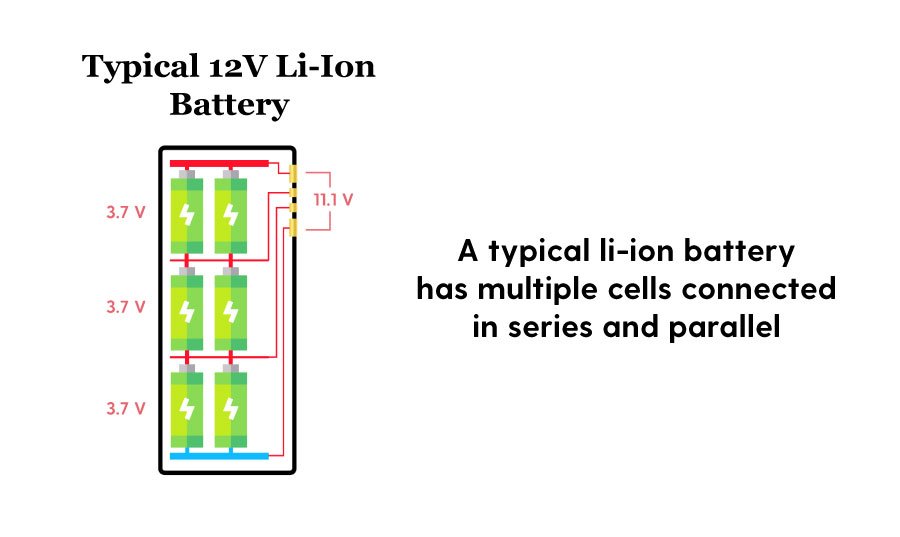
Standard Un-Balance Charge
Now, let’s discuss balance and unbalanced charging. You will have seen multiple pins on a high-end cordless drill battery. These multiple pins are connections to each cell stack to balance charge it. As shown in the image above, every cell is individually accessible to charge.
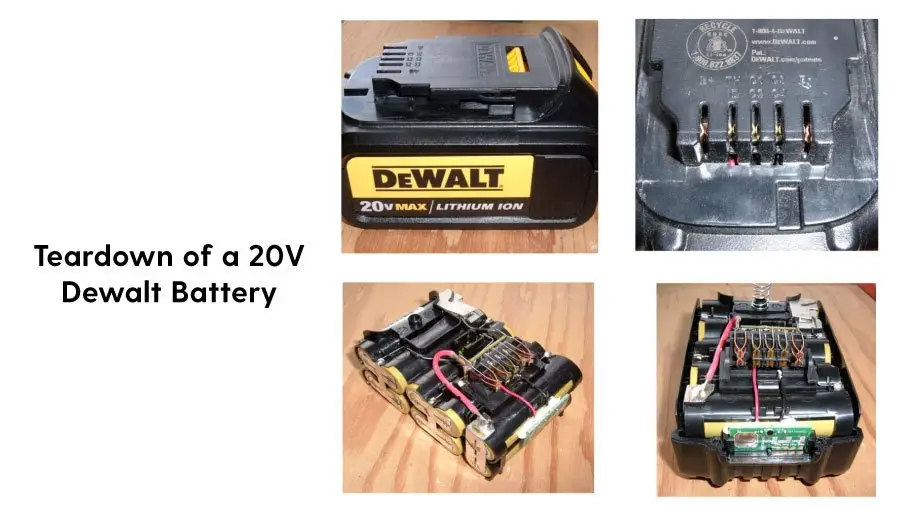
Learn more about battery internals at this link.
In a standard charge, all we have to do is apply the battery’s rated voltage at both main terminals and wait for the battery to charge. Just make sure toprovide the battery’s rated voltage at both terminals by connecting the positive terminal of the voltage source with the positive terminal of the battery you are charging and the negative terminal of the voltage source with the negative terminal of the battery you are charging.
To avoid any damage to the battery, it is recommended to charge at 12V rather than 12.6V. Although it’s safe to charge Li-ion batteries to 12.6v, I will not recommend taking the risk.
Balance Charge
Balance charging takes a different approach than a standard unbalanced charge. You will need special off-the-shelf balance chargers mainly used by RC plan enthusiasts. They are cheap but have great features, and you can control multiple battery parameters.
These chargers can also charge NiCad, Nimh, Lifo, and other rechargeable batteries.
The chargers provided by the drill manufacturers charge each cell and balance its voltage to be the same 4.1-4.2V when fully charged.
You will not be able to balance charge your Li-Ion yourself if you don’t have a balance charger.
The process involved charging each cell to the rated voltage and keeping all cells at the same level of charge. See the below image to understand how it works.
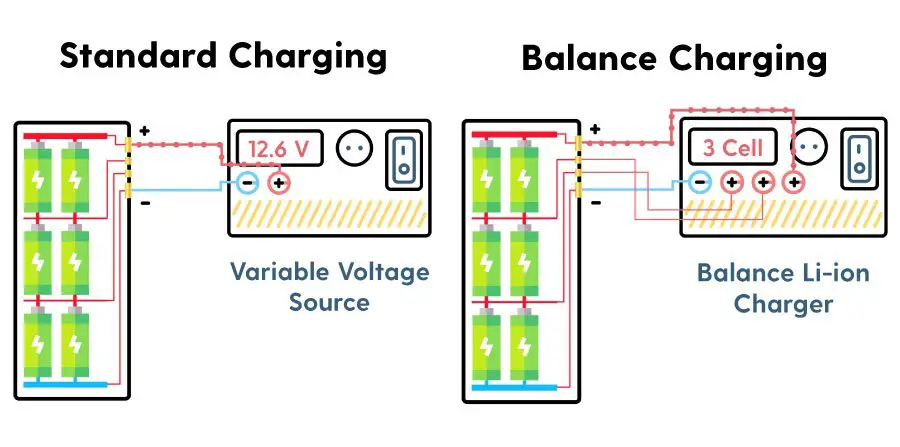
In balance charging, a dedicated Li-Ion off-the-shelf charger can be utilized which balances the voltage of each cell to 4.2 Volt to maximize the battery health and life.
There are many off-the-shelf balance chargers you can buy on Amazon, but the SKYRC B6 is my favorite as it comes with a lot of connectors and cables which will help you charge any rechargeable batteries you have.
The Hacks: How to charge a cordless drill battery without the charger
Now, let’s move on to the most exciting part: how to charge any rechargeable battery without the official charger at home when you don’t have a balance charger or variable voltage source.
We normally do not have a variable voltage source lying around. These voltage sources are expensive and hard to find. So, we need to find a hack to charge our dead battery.
Assumption: I assume that you will probably charge an old battery that comes with your outdated drill, and you no longer want to invest in a new charger, or the charger is not available in the market.
I recommend buying a proper charger for newer batteries to extend the battery life. Replacement chargers are readily available on Amazon. (Check this link, add your drill brand name and voltage to the search query)
So, let’s come to the point. As discussed earlier, all you need is the same amount of voltage as the battery.
Following are a few ways you can get that desired voltage:
- Your Car battery – A perfect 12V voltage Source
- Laptop Charger – 12V to 18-19V Voltage Source
- Simple AA Cells – Any amount of voltage can be built up
- Cheap Voltage Regulators/Converters
- Another Drill Battery
- Solar panel
Charge a cordless drill battery with the car battery
DO IT AT YOUR OWN RISK:
Risk Involved – Shorting car battery terminals, overcharging a low-rated voltage battery to 12V, and exploding it.
A car battery is one of the best ways to charge your 12V cordless drill battery. You don’t need to charge your car battery as that will be automatically charged by your car alternator when you drive. Incases your car battery is dying, and you need a replacement, this is the one I always use with my cars. They come with a 36-month warranty.
All you need to do is, connect the drill battery terminals with the car battery terminals. As stated earlier,connect the positive terminal of the car battery with the positive terminal of the battery you are charging and the negative terminal of the car battery with the negative terminal of the battery you are charging.
If you have the same car battery being used for other things like UPS etc., at home, you can use that as well. Make sure the battery you are going to charge has a rated voltage of 12V & your car battery is also rated at 12V.
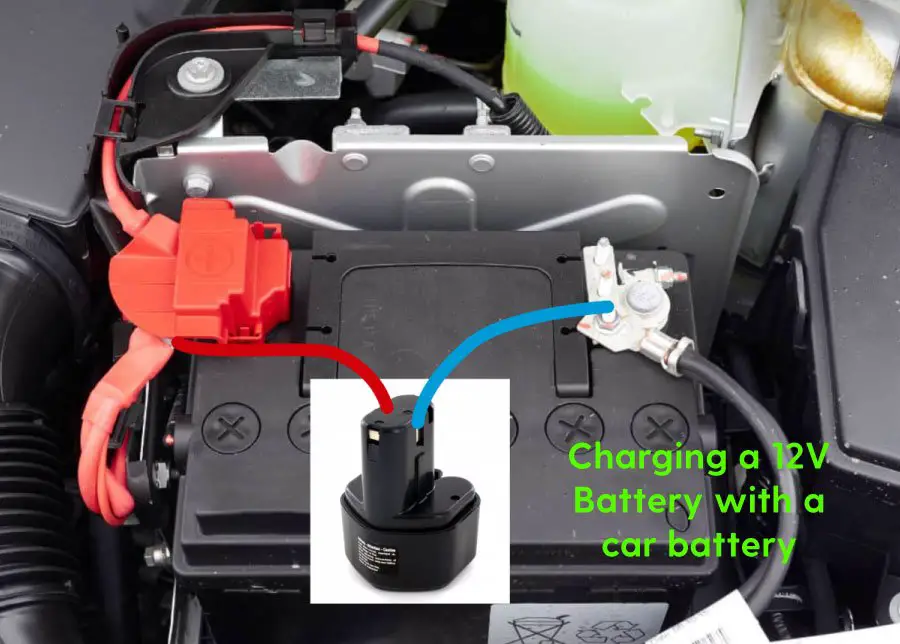
Charging a Cordless Drill Battery with a Laptop Charger
Most laptop chargers are rated for 18-20V, which is very suitable for charging an 18V battery. The process is simple. Understand the type of connector your laptop charger has.
After that, get a hold of a compatible female connector (Get these connectors). Solder the female connector with the internal battery connections (Positive with positive and negative with negative). Make a cut-hole for the female connector to sit in, and voila, you can charge your battery without the official charger.
If you don’t want to get bothered with the connector type, get an off-the-shelf two-pin connector set like this one, and make connections in a way positive aligns with positive and negative with negative.
An Apple Macbook chargers (The old Megsafe ones) are rated at 14/16/18/20V. You can easily charge an 18V battery with the 18-20 volt chargers. Do check the output voltage ratings on the back of the charger.
Again, the process is simple,connect the positive terminal of the laptop charger with the positive terminal of the battery you are charging and the negative terminal of the laptop charger with the negative terminal of the battery you are charging.
It is a little complicated to take the connection from the pins of a Magsafe charger, and almost impossible to get hold of the female pin socket for it, so you will have to cut down the Magsafe connector.
Note that the center’s wire will be the positive terminal, and the outer mesh will be negative. Caution: This will irreversibly damage your MagSafe charger.
Charging battery with off the shelf 1.5V AA Cells
This is an expensive and inefficient way, but it can be life-saving. In an extreme case, when you can’t find any voltage source, you can get hold of simple off-the-shelf 1.5V AA Cells and connect them in series to make up the desired voltage (A voltage equivalent to the battery you are going to charge).
9 Cells in series for a total of 13.5V to charge 12V battery and 13 cells in series for a total of 19.5V to charge 18V battery. They may not fully charge your battery as these cells have a minimal capacity.
You can also get hold of rechargeable AA cells, and they mostly come with a charger, but that will be expensive. Still, worth sharing.
Charging battery with Cheap Voltage adapters
The process is the same as in laptop chargers, but cheap voltage regulators are available at electronic shops and online. Get these 12V and 18V adapters from Amazon, and they will work great. I found this one to be pretty convincing. It is cheap and comes with many connectors to connect with the battery.
You may find these already lying around at your home, which may have come with electronic devices like Bluetooth speakers, min fans, or toys. Do a thorough search.
Charging battery with another drill battery
Charging a rechargeable battery with another fully charged battery is also a great hack. For example, if you have another drill battery with a working charger, you can use that drill battery to charge your battery.
Again, science is the same. Make sure the other battery is of the same voltage and fully charged. Now connect the terminals in the same polarity. Positive with positive and negative with negative. You will have to use jump wires for the connections. It will not be a solid solution but can work in an emergency.
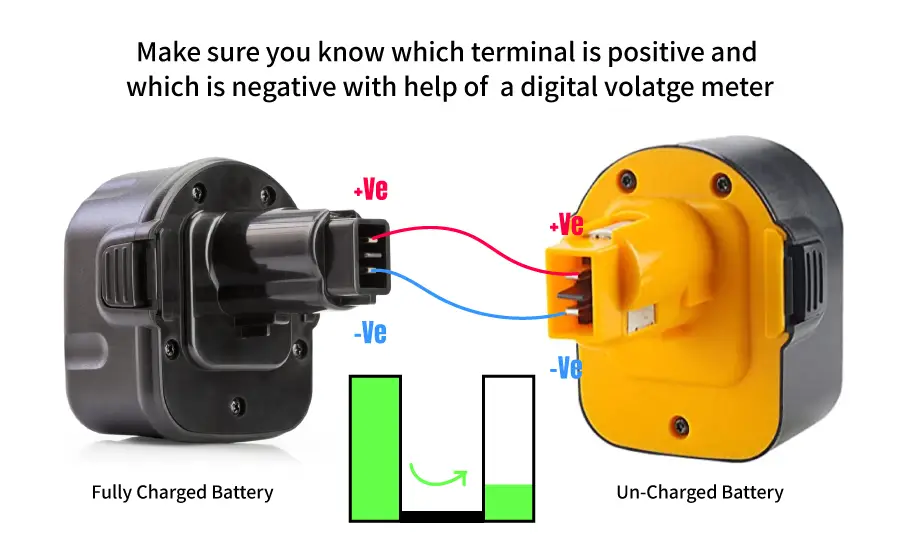
You can also buy universal drill battery charges from Amazon. Check the options here.
Charging battery with solar panel
Solar Panels are a great source of DC Voltage Source. However, there is one problem. The Output voltage is not constant and varies due to the change in sun direction and temperature.
A 12V rated solar panel has an output voltage of 17 volts, which is regulated down to 13-15 volts to charge a 12V battery.
Just make sure the panel is designed for a 12V battery system, and then you can connect it directly with your battery without an MTTB controller. Make sure your battery does not become too hot to avoid any incident. I will personally recommend this 12V panel.
Caution: These are all hacks, and you shall perform them with extra care and precaution.
How to charge a car battery without a charger
So charging a car battery without a charger also needs the same technique as charging a cordless drill battery, however, you will need a powerful charger or will need to charge the car battery for a quite long to charge it.
The best way to charge a car battery without a charger is by using a high-power (Watts) 12V voltage source. Connect the positive terminal of the voltage source with the car battery’s positive terminal and the negative terminal of the voltage source with the car battery’s negative terminal and turn on the power source by plugging it in a power outlet. You will have to wait a couple of hours before it’s fully charged.
You can use this 12V power source from Amazon.

How to charge Ryobi 40v battery without charger
The basic science is again the same for charging a high voltage battery without a charger. To charge a 40V battery, you will need a voltage source of 40V. You can get this voltage source in different ways.
One way is to connect 3 12V batteries (The actual voltage of a 40V battery is 36 Volt – but it jumps to 40 when fully charged) in series and charge your 40V battery with it.
However, it’s a risky method. I will recommend getting this variable voltage source from Amazon which can go up to 60V.

Again, the process is simple,connect the positive terminal of the variable voltage source with the positive terminal of the 40v Ryobi battery and the negative terminal of thevariable voltage source with the negative terminal of the 40V Ryobi battery. Now adjust the output voltage of your variable source to 40V and your battery will start charging.
Make sure to keep a multimeter with yourself to keep monitoring the voltage of your battery.
How to charge Milwaukee m18 battery without charger
The Milwaukee m18 batteries are rated at 18V and you can charge them using a laptop charger rated at 18V or get yourself an inexpensive variable voltage source that can provide a terminal voltage of 18V.
Thenconnect the positive terminal of the variable voltage source with the positive terminal of the Milwaukee m18 battery and the negative terminal of thevariable voltage source with the negative terminal of theMilwaukee m18battery. Now adjust the output voltage of your variable source to 18V and your battery will start charging.
You can also charge a craftsman v20 volt cordless drill battery using the same technique.
You can get this inexpensive variable voltage source for this project.

Can you charge an 18v battery with a 12v charger?
No, you can not charge an 18V battery with a 12V charger. If you plug in an 18V battery inside a 12V charger, it will indicate that your battery is fully charged as a 12V charger only brings up the voltage to 12V from a lower voltage.
Additional Read: